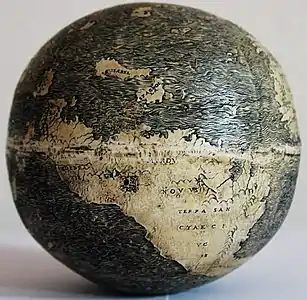Ostrich Egg Globe
The Ostrich Egg Globe is a hollow terrestrial globe made from the conjoined lower halves of two ostrich eggs.[1] The map carved on the globe is an extremely close,[1] if not identical,[2] match to the Hunt–Lenox Globe, a copper globe reliably dated to about 1510. The owner[2] of the Ostrich Egg Globe, Stefaan Missinne, claims that it was made in the early 16th century and is therefore the first globe ever to depict the New World.[1][3]

Missinne's theories
The globe's primary investigator, Stefaan Missinne, claimed in 2013 that the globe had been "found"[4] at the London Map Fair in 2012,[4][1] by an owner who preferred to remain anonymous; that it had passed through at least two dealers' hands already; and that it "had been part of an important European collection for many decades"[4] before that.
Missinne further claimed that the remarkable similarity between the maps on the Hunt–Lenox Globe and the Ostrich Egg Globe indicated that contrary to popular belief, "the Lenox Globe was not engraved, but rather cast from the ostrich egg globe using a very specific and unusual technique,"[4] and that in fact this casting process must have happened before the two halves of the Ostrich Egg Globe were joined together,[4] giving the Ostrich Egg Globe effectively the same age as the Hunt–Lenox Globe.
Further, in 2013, Missinne claimed that the globe showed "influence from Leonardo's workshop."[4]: 19 By 2017 he had gained enough certainty to claim that the globe was crafted in precisely 1504 by a left-handed engraver[5] whom Missinne identifies[5] as Leonardo da Vinci himself.
In 2018, Missinne published a book titled The Da Vinci Globe (the title a reference to The Da Vinci Code (2003)) promoting his theory of the globe's provenance. Cartographer Wouter Bracke, reviewing The Da Vinci Globe in 2019, stated that Missine's book should be considered "a report on the author's research into the globe and [not] a final scientific and academic publication," and that Cambridge Scholars Publishing's lack of editorial board "clearly failed to guide the author in the preparation of his publication." Ultimately, while Bracke seems to accept the idea that the Ostrich Egg Globe is a true product of the "early 16th century,"[2] he states that more research is needed into its provenance and recent history.
See also
References
- Meeri Kim (19 August 2013). "Oldest globe to depict the New World may have been discovered". The Washington Post. ISSN 0190-8286. Archived from the original on 9 December 2013. Retrieved 21 August 2020.
- Wouter Bracke (2019). "The Da Vinci Globe by Stefaan Missinne (review)" (PDF). Maps in History. 64 (64): 13–15.
- Breanna Draxler (19 August 2013). "Engraved Ostrich Egg Globe is Oldest to Depict the New World". Discover. Retrieved 28 November 2021.
- Stefaan Missinne (Fall 2013). "A Newly Discovered Early Sixteenth-Century Globe Engraved on an Ostrich Egg: The Earliest Surviving Globe Showing the New World" (PDF). The Portolan: Journal of the Washington Map Society (87): 8–24.
- Geert J. Verhoeven; Stefaan Missinne (2017). "Unfolding Leonardo da Vinci's globe (AD 1504) to reveal its historical world map". ISPRS Annals of the Photogrammetry, Remote Sensing and Spatial Information Sciences. Germany: Copernicus Publications. IV-2/W2: 303–310. Bibcode:2017ISPAn.4W2..303V. doi:10.5194/isprs-annals-IV-2-W2-303-2017.
Further reading
- L. Salvatelli, J. Constable, Riflessi (ed enigmi) in una sfera di vetro, in Medioevo, 279 (2020), pp. 12–16.
- L. Salvatelli, J. Constable, Some Notes on Magnifying Globes and the Salvator Mundi
- https://www.rtve.es/play/audios/punto-de-enlace/globo-terraqueo-leonardo-mas-antiguo-del-mundo/6907384/